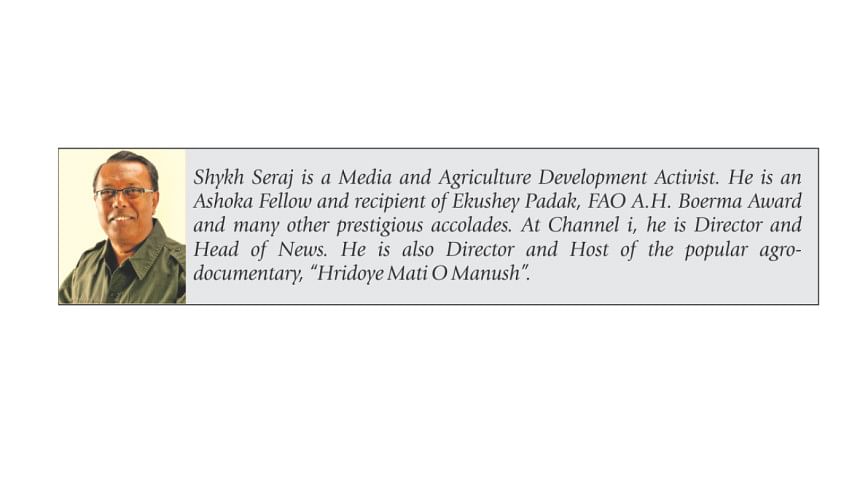Boundless prospect of hilsa

Hilsa, a fish that has emotional bondage with the Bengali community living across the world, is engaged with our life, literature and culture. The taste and smell of hilsa fascinate us in many ways. I was born on the bank of Meghna river in Chandpur. It is said that the home of hilsa is Chandpur. Since my childhood, I have such a deep connection with hilsa. I have gone to the deep Meghna river many times on fishermen's boat to see how they catch the fish. I heard the history of the old Hilsa Ghat in Chandpur, which is 400 to 500 years old. There were direct launches from Kolkata. I have seen hilsa in the ghat since I was a boy. The season of hilsa means a festival to me, to the Bengalis.
Silver crop hilsa carries the identity of Bangladesh. I read in the newspaper a few days back, which quoted a research that mentioned hilsa is the only fish in the world, whose religious, social and socio-cultural value is over two and a half thousand crore taka (About USD 259 million). Hilsa can become an even powerful sector of our economy.
Various initiatives are being taken to increase the production of hilsa and to protect it. Among them, all kinds of fishing are prohibited during the spawning season of hilsa in the river for 22 days, starting from October 14. There are also two off-seasons for catching fish. Sometimes there is strict monitoring, sometimes there is no sign of it. I have talked to the fishermen many times. They complained that many of the real fishermen did not get government benefits. Again, in the off-season of hilsa, many amateurs are enjoying the government benefits illegally. The project titled 'Development and Management of Hilsa Resources' worth Tk 248.27 crore (USD 29.30 million) was approved at the ECNEC meeting on September 22 to increase the production of hilsa. I have learned from various news sources that the project will increase the production of mother hilsa and jatka (hilsa fry) conservation through implementation of fisheries conservation act and sanctuary management, ensuring alternative employment for 30,000 fisher families, creating awareness on distribution of 10,000 legal nets and conservation of mother hilsa and jatka. Undoubtedly, it's a timely initiative.
A mother hilsa has 10 lakh (one million) eggs. Killing a mother hilsa means destroying 10 lakh hilsa fishes. Hilsa, smaller than 10 inches is considered as jatka and catching them is banned. As a conscious and responsible citizen of the republic, one should refrain himself from buying jatka no matter what the price is. In 2019, I visited Hilsa Research Centre in Chandpur. At that time I spoke in detail to the then Principal Scientific Officer Md Anisur Rahman. He said that the production of hilsa has increased due to improved hilsa management strategies. He said that till the year 2000, the production of hilsa was at best 1,50,000 tonnes a year. In 2010, the production of hilsa went up to 3,12,000 tonnes. Last year, the production went further up to 5,33,000 tonnes. This is the result of maintaining the right production method and conservation strategy.
According to the Department of Fisheries, the production of hilsa is increasing at a rate of around 10 percent every year in Bangladesh. Hilsa production has increased by 66 percent in the last nine years. Hilsa of Bangladesh has already taken a permanent place in the international arena. This recognition as a geographical indicator or GI product is one of the far-reaching cultural achievements of Bangladesh. Hilsa is now Bangladesh's product.
Hilsa is a sea fish. At some point in its life cycle, it leaves the salty water and finds the new abode in the freshwater. It's a diversified fish. From May 20 to July 23, all kinds of fishing is not allowed in the sea. This time is also very important. However, at that very period, big Indian trawlers enter our waters and catch hilsa from the sea. As a result, the aim in which we are refraining from catching hilsa, gets undermined, says the fishers.
In 2019, I went to Ocean University in Qingdao, China, to learn about their research on the fisheries. I discussed with Professor Chun Leo, a fisheries researcher, about the conservation, research and other issues related to fishing at seas. He said that if a safe environment and pathway from the sea to the rivers for hilsa could be created, its production will increase even more. Professor Chun Leo also suggested that the maritime boundaries of Bangladesh, India and Myanmar are very significant in creating this safety net for hilsa to grow more; hence a united effort from these countries would ensure a far better outcome, in regards to the environmental and economic aspect of hilsa.
The contribution of hilsa to our culture and economy is undeniable. Hilsa accounts for 11 percent of the annual fish production in Bangladesh. Seventy-five percent of the world's total hilsa production comes from Bangladesh. Apart from Bangladesh, several other countries including India, Pakistan and Myanmar produce hilsa. About 35 lakh (3.5 million) people of the country are directly or indirectly involved in hilsa fish industry. Multifaceted measures are required to further enhance the protection, expansion and economic potential of hilsa industry. In particular, navigability is a must and rivers must be sheltered from pollution.
To keep the production of hilsa, a sustainable and effective decision has to be taken in the light of more advanced research, regarding production and netting the fish from both sea and rivers. It's significant when we're looking forward to prospering in blue economy and working steadily on 100-year delta plan. In particular, it is necessary to explore the zones of the sea where hilsa roams most. No trawler zone should be ensured at the hilsa roaming areas. Hilsa production also depends a lot on the climate. The context of climate change needs to be brought to the fore in all research and planning. If all of these come into reality, we can say we are looking at even wider and brighter future of hilsa production in Bangladesh, which will surely take us to an unimaginable field of prosperity.


 For all latest news, follow The Daily Star's Google News channel.
For all latest news, follow The Daily Star's Google News channel. 



Comments